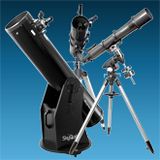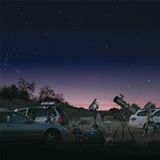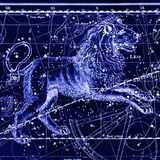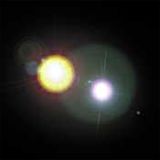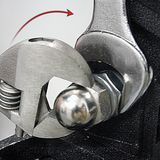
One of the most fascinating aspects of the science of astronomy is the concept of distance. Everything in the night sky is so incredibly remote! Even the closest star to our solar system, the Alpha Centauri triple-star system, is 25 trillion miles away. The thousands of other stars that we see every clear night with the naked eye, as well as the millions of stars visible through telescopes and binoculars, are farther still!
Scattered among those distant suns are fascinating sights called deep-sky objects, a general catch-all phrase that includes a wide variety of celestial denizens. These include huge clouds of gas and dust called nebulas, which can be divided further into emission nebulas, reflection nebulas, and planetary nebulas. The first two are associated with stellar birth, while the latter are expanding shells expelled from dying stars. Star clusters form a second grouping of deep-sky objects. Open star clusters are made up of anywhere from a dozen to several hundred young, chiefly blue-white stars. Most of these stellar swarms lie within the spiral arms of our own galaxy, the Milky Way. Globular star clusters, made up of some of the oldest stars known, surround the hub of our pinwheel-shaped Milky Way. Each contains between 100,000 and a million constituents. Finally, beyond our Milky Way, are myriad island universes called galaxies. Some are spiral shaped like our own, while others are elliptical or irregular in appearance.
Messier and NGC: A Lifetime of Treasures
Deep-sky objects are usually designated by catalog numbers, such as M42 or NGC 869. The Messier catalog, is the most famous listing of deep-sky objects. Created by Charles Messier, an 18th-century comet hunter, this catalog consists of 109 of the finest objects the sky has to offer. Finding all of the "M" objects is a great introduction into deep-sky observing, since most are bright enough to be seen even through modest equipment. The New General Catalogue of Nebulae and Clusters, or NGC, was compiled in the 1880's by John Dreyer and based on observations by the father-son team of William and John Herschel. More than 7,800 objects are listed in the NGC, certainly more than enough to occupy the owners of even the largest backyard telescopes for a lifetime.
Spotting deep-sky objects through binoculars and backyard telescopes is one of the most exhilarating, challenging, and thought-provoking aspects of the hobby of astronomy. To help set you off on the right foot, here is our top ten list of splendors. Few celestial sights rival these exciting objects. All are visible through modest amateur telescopes, and most can even be seen with binoculars.
- M44 Beehive Cluster in Cancer (spring)
- M51 Whirlpool Galaxy in Canes Venatici (spring)
- M13 Great Globular Cluster in Hercules (summer)
- M57 Ring Nebula in Lyra (summer)
- M27 Dumbbell Nebula in Vulpecula (summer)
- M8 Lagoon Nebula in Sagittarius (summer)
- M31 Andromeda Galaxy (autumn)
- NGC 869 & NGC 885 Double Cluster in Perseus (autumn)
- M42 Great Orion Nebula (winter)
- M45 Pleiades Cluster (winter)
Beyond the brighter, showpiece members of the Messier and NGC lists are thousands of other deep-sky objects. Most will test your skills as an observer, but that is the thrill of the challenge.
Tips for Deep-Sky Observing
You don't necessarily need to be a veteran amateur astronomer to enjoy deep-sky observing. Here are a few tips from the experts to give you a head start.
- Always try to plan your observing session by knowing what objects you want to look for before venturing outside. By first locating each target object on a star atlas during the day, you can make the most out of the night by heading straight for your preselected sights. List the objects in the order in which they will be found, but limit the selection to no more than a dozen. This way, you won't feel the need to race from one to the next.
- While it is still daylight, check the optical collimation of your telescope. This is especially important with reflectors and Schmidt-Cassegrain telescopes, whose optics may be shifted out of alignment when they are moved. Then, after it is set up at night, check it again to see if it needs any minor tweaking. Also make certain that all optics are clean. A little grime on an eyepiece can make the difference between seeing an object and not.
- Try to find a dark observing site. While it is certainly possible to find deep-sky objects from the center of a city, there is no beating a rural sky. Better still, join a local astronomy club and attend their star parties. Observing is always more fun with a group.
- While some of today's telescopes feature computer-aiming devices, it is best to learn your own way around the sky. Star-hopping is the most popular technique for finding deep-sky objects. All you need, besides a telescope or binoculars, is a star chart of some kind and, for lighting, a red flashlight. Aim your telescope at a known, naked-eye star near the target object, then hop between fainter stars until the telescope is pointed at the target's location.
- Take your time when searching for faint objects and use averted vision. Instead of looking directly at the target area, look off a little to one side of the eyepiece's field of view. This is called using averted vision. The edge of the eye's retina is more sensitive to dim light than the center, which makes it possible to glimpse faint objects. Another trick for spotting difficult objects is to tap the side of the telescope tube lightly, just enough to jiggle the field of view.
- If at first you don't succeed, change eyepieces. It's best to start with low power (20x-50x or so), since images become dimmer at higher powers, and most deep-sky objects are already dim enough! Many people are under the false impression, however, that deep-sky observing can only be done with low magnification. Not true. Medium- to-high power eyepieces are perfect for uncovering small objects like planetary nebulas and galaxies.
- Narrowband light-pollution filters may also prove useful, but really only on emission and planetary nebulas. They enhance the contrast between the object and the background sky.
- Making a record of everything you observe by taking notes and making drawings is a great way to train your eye to see subtle details (and to remember what you see from one observing session to the next). Jot down all important details of the observation, including the object's catalog number, date and time, observing location, telescope and eyepiece(s) used for the observation, sky conditions and any interferences, and a description of the object. Afterwards, keep everything together in a large observing log.
Above all, sit down, relax, and enjoy the view. Dress warmly enough to be comfortable, but not so that you overheat.
As you peer through your eyepiece, remember this: you are seeing an object so distant that its light left there hundreds, thousands, even millions of years ago, and is only arriving here now. You are seeing this cosmic denizen as it was way back then; you're truly looking back in time. Even more amazing, you are not just looking at a photograph ? you are seeing it yourself, with your own telescope! That?s what makes deep-sky observing so exciting!




